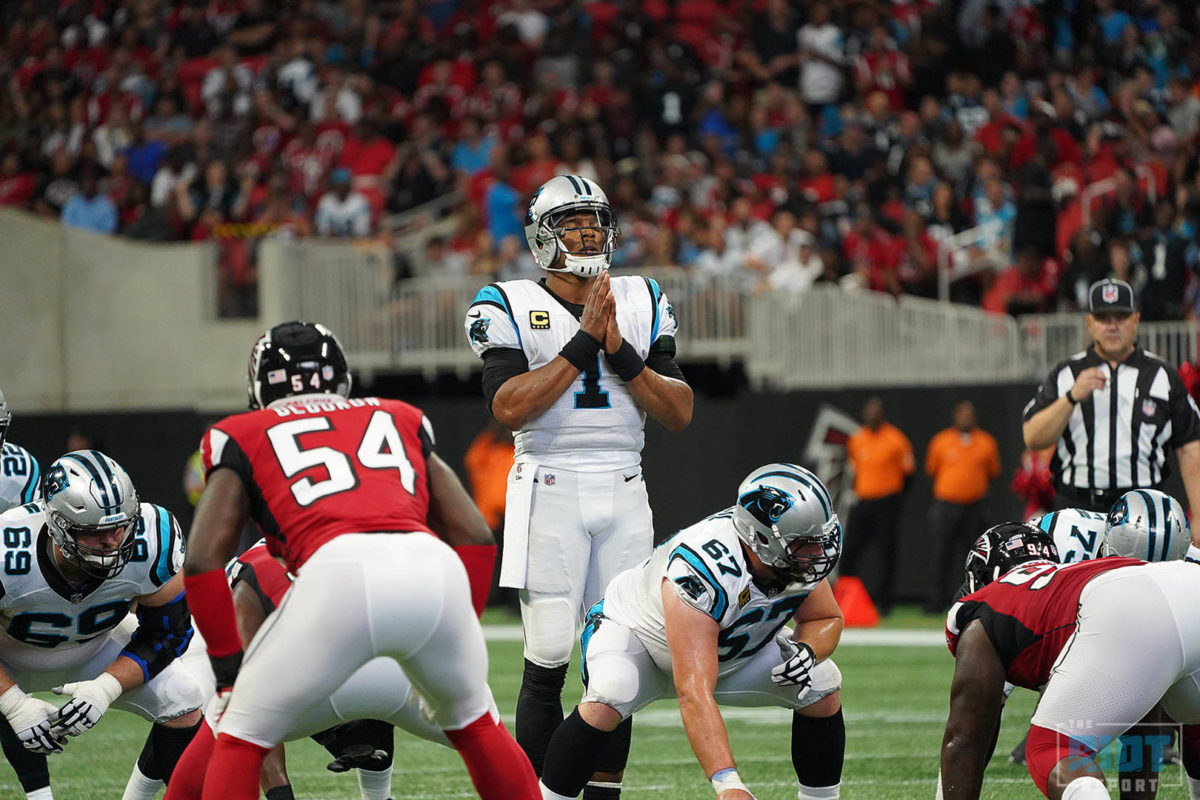Why did the Panthers lose to the Falcons?
There is of course a flippant answer to this: the Panthers conceded more points than they scored.
But even this simplistic explanation splits the problem in two: the points they failed to score and the points they allowed. The latter was a clear issue for the Panthers on Sunday, as even without their starting running back, the Falcons were able to put up 31 points and over 400 yards on the Panthers, including 170 yards on the ground; the causes of this, while undeniably things the Panthers need to work on, are fairly simplistic in nature: gap discipline, tackling and pass rush.
The offense on the other hand, presents something of a confusing picture.
After all, the raw numbers from the offense look good – the Panthers offensive line only allowed two sacks, the team put up over 120 yards on the ground while averaging a ludicrous 6.7 yards per carry average and Cam Newton completed 71.1% of his passes for 335 yards and three touchdowns. The only real blemish for the Panthers in terms of the box score is the lone interception, and even that came well into the fourth quarter when the Panthers were already down two scores and chasing the game.
The real question is how, despite all this apparent offensive production, the Panthers ever managed to go down by two scores, let alone do so less than six minutes into the third quarter. Why doesn’t the box score match the score on the board for the Panthers?
Perhaps the answer to this lies in one number: 33%, the Panthers first half third-down conversion rate.
A Numbers Game
There is a great line in the film Moneyball where Jonah Hill’s character sums up the flaw with conventional baseball thinking at the time. “The people who run ball clubs, they think in terms of buying players. Your goal shouldn’t be to buy players, your goal should be to buy wins.” While Hollywoodized, this sums up the only statistic that is actually important in every sport the world over: wins. However, if that rationalization is taken just three steps further, everything goes a little haywire. What do you need to do to win games? Well, that’s the flippant answer given earlier: score points. So what do you need to do to score points? Well…
The most obvious answer to this is score touchdowns and field goals, but in reality that is simply the same answer from the previous question only rephrased. This is not an issue that the analytics-heaven of baseball has to deal with; a hit and walk are always going to be a positives – if a team consistently gets hits and walks, they will score runs. Simple.
This is football’s weird quirk: going forward isn’t enough to necessarily lead to points to necessarily lead to wins.
What will lead to points, however, are first downs. The issue with judging an offense by the number of first downs they generate is that an offense doesn’t work in terms of first downs – but in yards – which as we have already said cannot be used as a metric for offensive success. So what might make sense as an effective offensive metric?
Ball and Chain
The idea of down and distance is possibly best distilled in the concept of being ahead or behind the chains, and this is quite possibly the best way to judge an offense – how often they fall behind the chains based on the down and distance. For example, on first-and-10, this would require a team to gain less than four yards, but on second down and nine this would be a gain of less than five. By judging a team based on this metric we can get an idea of how effective the offense actually was, beyond the box score metrics. So how did the Panthers fare in this regard against the Falcons?

There are some things that should probably be pointed out before going any further, most notably that the numbers for second-down runs and fourth downs are extremely limited – so it is probably best to not make too much out of these numbers. Instead, let’s focus on the first downs and the passing on second and third downs.
The first down rushing success is extremely promising, and it is quite frankly frustrating that the Panthers didn’t look to the ground game more, as even with the second-down runs, the Panthers got beyond the gain line on over 70% of rushing plays. While the Panthers were chasing the game late in the fourth, they likely turned away from the ground game too early – even in the third quarter they had enough time left to not have to worry about not running the clock on rushing plays. Given that, the 68/32 split in favor of passing plays on first downs is something the Panthers should want to change going forward, something that is represented in the relative success rates of first down runs and passes.
Despite this, the fact that the Panthers had success rates of over 60% on both rushing and passing plays is something that Norv Turner should be pleased with, as the Panthers generally did a very good job of avoiding long third downs. Given this fact, the third-down conversion rate of under 50% stands out as an issue, something that is made even more significant when one bears in mind that before their fourth quarter comeback the Panthers had started 2-for-8 on third down before converting their final three attempts of the game.
So why weren’t the Panthers able to do better on third downs early on?



